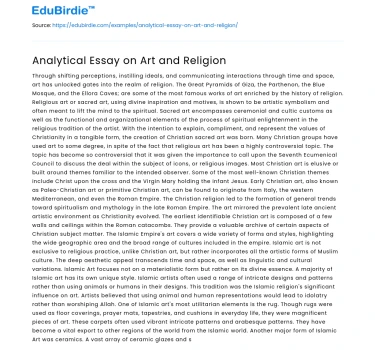Through shifting perceptions, instilling ideals, and communicating interactions through time and space, art has unlocked gates into the realm of religion. The Great Pyramids of Giza, the Parthenon, the Blue Mosque, and the Ellora Caves; are some of the most famous works of art enriched by the history of religion. Religious art or sacred art, using divine inspiration and motives, is shown to be artistic symbolism and often meant to lift the mind to the spiritual. Sacred art encompasses ceremonial and cultic customs as well as the functional and organizational elements of the process of spiritual enlightenment in the religious tradition of the artist.
With the intention to explain, compliment, and represent the values of Christianity in a tangible form, the creation of Christian sacred art was born. Many Christian groups have used art to some degree, in spite of the fact that religious art has been a highly controversial topic. The topic has become so controversial that it was given the importance to call upon the Seventh Ecumenical Council to discuss the deal within the subject of icons, or religious images. Most Christian art is elusive or built around themes familiar to the intended observer. Some of the most well-known Christian themes include Christ upon the cross and the Virgin Mary holding the infant Jesus. Early Christian art, also known as Paleo-Christian art or primitive Christian art, can be found to originate from Italy, the western Mediterranean, and even the Roman Empire. The Christian religion led to the formation of general trends toward spiritualism and mythology in the late Roman Empire. The art mirrored the prevalent late ancient artistic environment as Christianity evolved. The earliest identifiable Christian art is composed of a few walls and ceilings within the Roman catacombs. They provide a valuable archive of certain aspects of Christian subject matter.
Save your time!
We can take care of your essay
- Proper editing and formatting
- Free revision, title page, and bibliography
- Flexible prices and money-back guarantee
The Islamic Empire's art covers a wide variety of forms and styles, highlighting the wide geographic area and the broad range of cultures included in the empire. Islamic art is not exclusive to religious practice, unlike Christian art, but rather incorporates all the artistic forms of Muslim culture. The deep aesthetic appeal transcends time and space, as well as linguistic and cultural variations. Islamic Art focuses not on a materialistic form but rather on its divine essence. A majority of Islamic art has its own unique style. Islamic artists often used a range of intricate designs and patterns rather than using animals or humans in their designs. This tradition was the Islamic religion's significant influence on art. Artists believed that using animal and human representations would lead to idolatry rather than worshiping Allah. One of Islamic art's most utilitarian elements is the rug. Though rugs were used as floor coverings, prayer mats, tapestries, and cushions in everyday life, they were magnificent pieces of art. These carpets often used vibrant intricate patterns and arabesque patterns. They have become a vital export to other regions of the world from the Islamic world. Another major form of Islamic Art was ceramics. A vast array of ceramic glazes and styles were developed by early Islamic artists. Chinese porcelain invigorated many Islamic artists, whereas others introduced their own individual unique method of glazing pottery. Islamic artists created exceptional masterpieces incorporating ceramic tiles in addition to exquisite pieces of pottery. These tiles will oftentimes incorporate dazzling patterns and designs to incorporate upon walls or the entire exterior of religious temples.
The first known manifestations of Buddhist art predate back to Emperor Ashoka's reign during the Mauryan era (322-180 BCE), through the development of various stupas, similar to those at Sanchi, and the fabrication of pillars. Though Buddhism was rooted in India, a society of lavish religious iconography, early Buddhist art nearly exclusively eluded Buddha's metaphorical depictions. Alternatively, he and his pedagogy were expressed by symbols. These symbols included the Wheel of Law (dharma chakra), a symbol of the Four Noble Truths expressed by the Buddha, the Bodhi tree (precedented in the cult of fertility and the representation of the tree of life), the empty throne, the Lions (symbol of his royalty), and the Lotus, symbol of Buddha's pure, unspoiled nature. Buddhist art embraced believers as the dharma in every new host country as they expanded, accommodated, and established themselves. Through Central Asia and East Asia, it developed and implemented to the north to mold the northern branch of Buddhist art, as well as to Southeast Asia, to strengthen the southern branch of Buddhist art. In India, Buddhist art prevailed and encouraged the progression of Hindu art until Buddhism virtually vanished from India near the 10th century. The aforementioned is due to the rapid expansion of Islam adjacent to Hinduism. Greco-Buddhist art is the artistic representation of Greco-Buddhism, a cultural and religious syncretism that emerged over a period of approximately 1000 years in Central Asia, between the subjugations of Alexander the Great in the 4th century BC and the Islamic conquests of the 7th century AD.
Work Cited
- Cyr, Lisa. Art Revolution: Alternative Approaches For Fine Artists And Illustrators. North Light Books, 2009.
- Lazzari, Margaret R, and Dona Schlesier. Exploring Art: A Global Thematic Approach. 5th ed.
- McSwain, Stephen B. The Enoch Factor: The Sacred Art Of Knowing God. Smyth & Helwys Pub., 2010.
- Veith, Gene Edward. State Of The Arts. Crossway Books, 1991.






 Stuck on your essay?
Stuck on your essay?

